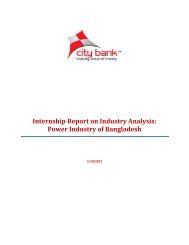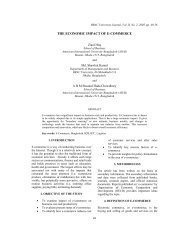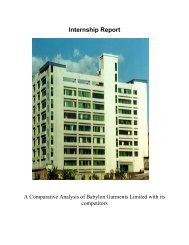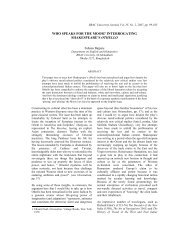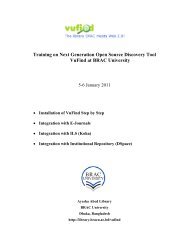design and simulation of a solar pv system - BRAC University ...
design and simulation of a solar pv system - BRAC University ...
design and simulation of a solar pv system - BRAC University ...
You also want an ePaper? Increase the reach of your titles
YUMPU automatically turns print PDFs into web optimized ePapers that Google loves.
The figure 20 shows the <strong>design</strong>ed <strong>solar</strong> <strong>system</strong> <strong>of</strong> <strong>BRAC</strong> <strong>University</strong>. This configuration<br />
showing that there is one combiner connected with 36 PV module. 12 PV modules in<br />
series in a string <strong>and</strong> there are 3 strings in parallel. For our <strong>system</strong> there would such 14<br />
configuration.<br />
The <strong>solar</strong> irradiance in Dhaka is 694.04 watt/day [ 5.2.2]. The energy supplied by the<br />
<strong>solar</strong> PV <strong>system</strong> in a year can be found by the following formula.<br />
Total energy supply = Maximum Power at defined irradiance <strong>of</strong> a <strong>solar</strong> panel *<br />
Average bright sunshine hour * 365 days * total no. <strong>of</strong> <strong>solar</strong><br />
panels<br />
= 173.51 * 7.55 * 365 * 492<br />
= 235.249 MWh/year<br />
Considering 80% <strong>of</strong> panel’s output efficiency the total energy supply = 188.39<br />
MWh/year<br />
The daily output energy is 515.62 kWh/day<br />
7.0 Design <strong>simulation</strong><br />
For the PV <strong>system</strong> <strong>design</strong>ed for <strong>BRAC</strong> <strong>University</strong> campus, we have chosen for<br />
<strong>simulation</strong> is PVSYST s<strong>of</strong>tware. PVSYST has several built-in mathematical models for<br />
component such as photovoltaic module, inverter <strong>and</strong> other tools.<br />
PVSYST gives two types <strong>of</strong> <strong>design</strong>ing options as preliminary <strong>design</strong> <strong>and</strong> project <strong>design</strong>.<br />
Using these options there are various kinds <strong>of</strong> <strong>system</strong> can be developed.<br />
For preliminary <strong>design</strong>:<br />
Grid connected <strong>system</strong>, st<strong>and</strong> alone <strong>and</strong> pumping – these three types <strong>of</strong> <strong>system</strong> can be<br />
<strong>design</strong>ed. Actually this is used to get a primary idea for users. There are three steps to<br />
<strong>design</strong> a <strong>system</strong> like have to define location <strong>and</strong> <strong>system</strong> sizing (select PV module type,<br />
technology, ventilation <strong>and</strong> mounting disposition). Then PVSYST will show users a<br />
result for that <strong>system</strong>.<br />
For project <strong>design</strong>:<br />
This is more elaborate than preliminary <strong>design</strong>. There are many options to define<br />
parameters for <strong>design</strong>ing a project <strong>of</strong> different types <strong>of</strong> <strong>system</strong>s like grid connected /st<strong>and</strong><br />
alone /dc grid connected/pumping.<br />
33



